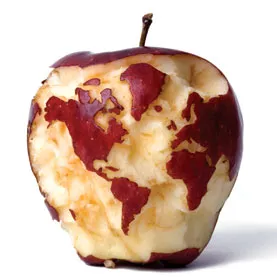
Can Organic Foods Feed the Future?
Organic farming is the only way to undo the frightening loss of precious topsoil, large-scale environmental pollution, and an ailing society of chemically contaminated people with which the past 70 years of farming in America have left us. The only feasible way forward is to nurture the soil, animals, and people back to health by cutting out synthetic chemicals and replenishing all of the nutrients we take out of the land—and the only way to do that is through organic farming. Organic farming is the future.
In 1990, the annual revenue for organic produce was $1 billion; by 2010, this figure had risen to $26.7 billion. The concept of organic farming has clearly caught the public’s imagination. Organic farming is the fastest growing sector of agriculture, currently increasing by at least 20 percent a year.
The more mainstream organic produce becomes, the more prices drop, gradually making organic food affordable to a wider range of households. Consumer awareness of the intrinsic value of organic food is growing, and now a quarter of the population buys organic at least once a week, compared to 17 percent a decade ago. If this trend continues, buying organic food will become an affordable option for ordinary families worldwide.
Organic fruits and vegetables are still more expensive than conventionally grown produce but not prohibitively so. Organic farmers do not enjoy the government subsidies or billions of dollars in research funds granted to commercial farmers through the USDA. Despite this, they have managed to not only survive but thrive. If the inequities of the federal funding system were adjusted and the indirect costs of conventionally farmed food are factored in, organic produce would be recognized as an undisputed bargain.
In the Farming Systems Trial—the longest-running comparative study of farming methods in America—the Rodale Institute evaluated chemical-based agriculture against organic farming over a 30-year period. Hands down, organic farming methods proved superior. The research shows that organic farms are potentially more profitable on less land, use less energy, are 28 percent more efficient, release 40 percent less emissions, are more adaptable, and, of course, are ecologically sustainable. Not only that, but organic methods provide employment to more people and allocate a larger percentage of the total investment to employee wages.
A lot of people recognize the sense in eating more organic produce but simply can’t afford it. If you have to narrow your choices, make fats such as butter and olive oil, dairy and meat your top priority. If organic butter, olive oil, and dairy and meat options are still beyond your budget, at the very least, buy from local dairies that do not use synthetic growth hormones.
As for produce, some conventional fruits and vegetables are safer than others. The following conventional items should be avoided because they are known to contain the highest traces of pesticide residues: apples, celery, strawberries, peaches, spinach, imported nectarines and grapes, sweet bell peppers, potatoes, domestic blueberries, lettuce, kale, and collard greens. If possible, always make these purchases organic.
Conventional crops generally treated with fewer pesticides include: onions, sweet corn, pineapples, avocados, asparagus, sweet peas, mangoes, eggplant, domestic cantaloupe, kiwi, cabbage, watermelon, sweet potatoes, grapefruit, and mushrooms.
What the Future Holds For Organic Foods
Approximately 70 percent of the world’s poorest and most vulnerable people live in rural areas. Small-scale organic farming can revitalize suffering rural communities by providing food and job security while protecting the environment. Organic farming is a win-win solution, far more sustainable than the practice of dumping tons of food aid on dependent societies, which in turns jeopardizes the livelihood of indigenous farmers, unable to compete with the price of cheaper and less nourishing “aid” food. The answer to the world’s food crisis is not about growing more food but about growing more good food in a way that is accessible to the people who need it.
For your own kitchen, you can plant a small organic garden in your yard or grow an heirloom tomato in a pot. You can cultivate organic sprouts on your windowsill. And you can certainly take responsibility for finding out where your food comes from and demanding better quality at fair prices. Locally grown organic food will feed the future.

